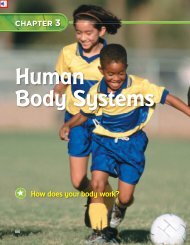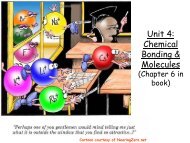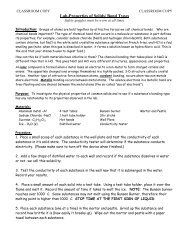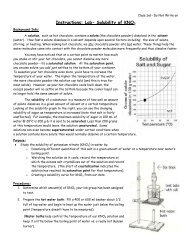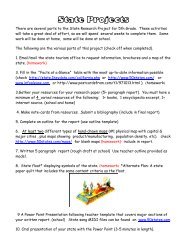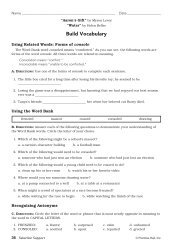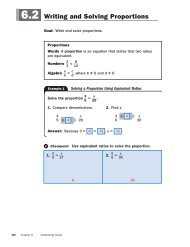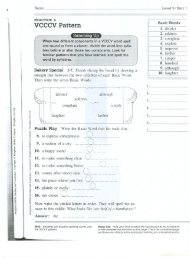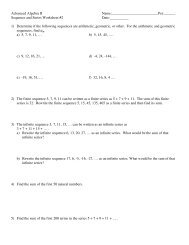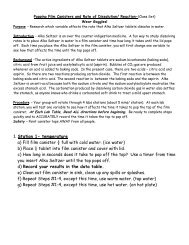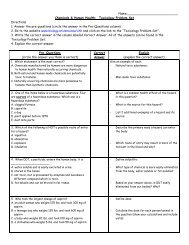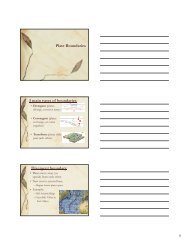Worked-out Problems
Worked-out Problems
Worked-out Problems
Create successful ePaper yourself
Turn your PDF publications into a flip-book with our unique Google optimized e-Paper software.
Chapter 3 continued<br />
34. ––CONTINUED––<br />
d. Monthly fee p Number of months Membership fee<br />
Your health club: 150 35m<br />
Your friend’s health club: 100 40m<br />
150 35m < 100 40m<br />
150 35m 40m < 100 40m 40m<br />
150 5m < 100<br />
150 5m 150 < 100 150<br />
5m < 50<br />
5<br />
<br />
m<br />
5<br />
> 50<br />
<br />
5<br />
m > 10<br />
You will have paid less than your friend after more<br />
than 10 months.<br />
3.6 Mixed Review (p. 153)<br />
35. Point A is 1 unit to the right of the origin and 3 units<br />
up. So, the x-coordinate is 1 and the y-coordinate is 3.<br />
Point A is represented by the ordered pair (1, 3).<br />
36. Point B is 3 units to the left of the origin and 1 unit down.<br />
So, the x-coordinate is 3 and the y-coordinate is 1.<br />
Point B is represented by the ordered pair (3, 1).<br />
37. Point C is 3 units to the right of the origin. So, the<br />
x-coordinate is 3 and the y-coordinate is 0. Point C is<br />
represented by the ordered pair (3, 0).<br />
38. Point D is 1 unit to the right of the origin and 3 units<br />
down. So, the x-coordinate is 1 and the y-coordinate<br />
is 3. Point D is represented by the ordered pair (1, 3).<br />
39. Point E is 4 units to the left of the origin and 4 units up.<br />
So, the x-coordinate is 4 and the y-coordinate is 4.<br />
Point E is represented by the ordered pair (4, 4).<br />
40. Point F is 1 unit to the left of the origin and 3 units up.<br />
So, the x-coordinate is 1 and the y-coordinate is 3.<br />
Point F is represented by the ordered pair (1, 3).<br />
41. 13(2a 1) 13(2a) 13(1) 26a 13<br />
42. 12 c 8 c 12 8 c 20<br />
43. 5a a (5 1)a 6a<br />
44. 3(x 4) 9<br />
3x 12 9<br />
3x 12 12 9 12<br />
3x 3<br />
3 x<br />
3<br />
<br />
3 3<br />
x 1<br />
Check: 3(x 4) 9<br />
3(1 4) 9<br />
9 9 ✓<br />
45. 4(2d 1) 28<br />
8d 4 28<br />
8d 4 4 28 4<br />
8d 24<br />
8 d<br />
2 4<br />
<br />
8 8<br />
d 3<br />
Check: 4(2d 1) 28<br />
4[2(3) 1] 28<br />
28 28 ✓<br />
46. 10 2(7 2x)<br />
10 14 4x<br />
10 14 14 4x 14<br />
24 4x<br />
24<br />
4x<br />
<br />
4<br />
4<br />
6 x<br />
Check: 10 2(7 2x)<br />
10 2[7 2(6)]<br />
10 10 ✓<br />
47. 3x 9 2x 7<br />
3x 9 2x 2x 7 2x<br />
x 9 7<br />
x 9 9 7 9<br />
x 16<br />
3.6 Standardized Test Practice (p. 153)<br />
48. D; 7 6x ≥ 13<br />
7 6x 7 ≥ 13 7<br />
6x ≥ 6<br />
6x<br />
6<br />
≤ <br />
6<br />
6<br />
x ≤ 1<br />
49. I; 7x 3 < 7.5<br />
7(3) 3 ? < 7.5<br />
18 < 7.5<br />
18 < 7.5, so 3 is a solution.<br />
Chapter 3 Review (pp. 154–157)<br />
1. The value of a variable that, when substituted into<br />
an inequality, makes a true statement is a solution of<br />
an inequality.<br />
2. Sample answer: 2x 3 ≤ 7<br />
3. The inequalities of 2x < 2 and x < 1 are equivalent<br />
inequalities.<br />
Copyright © McDougal Littell/Houghton Mifflin Company<br />
All rights reserved.<br />
Chapter 3<br />
Pre-Algebra 103<br />
<strong>Worked</strong>-Out Solution Key




